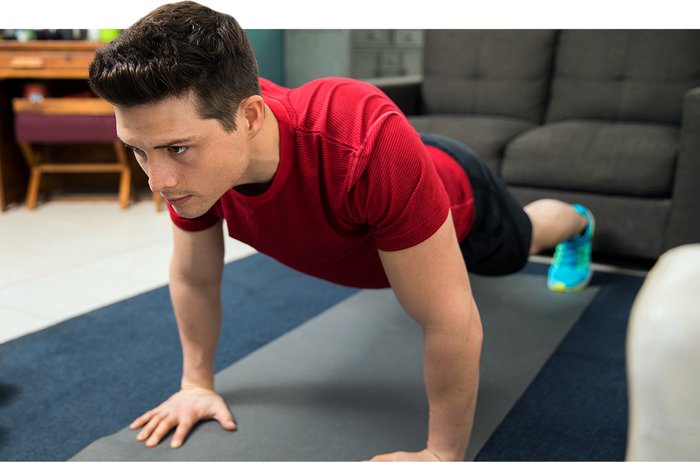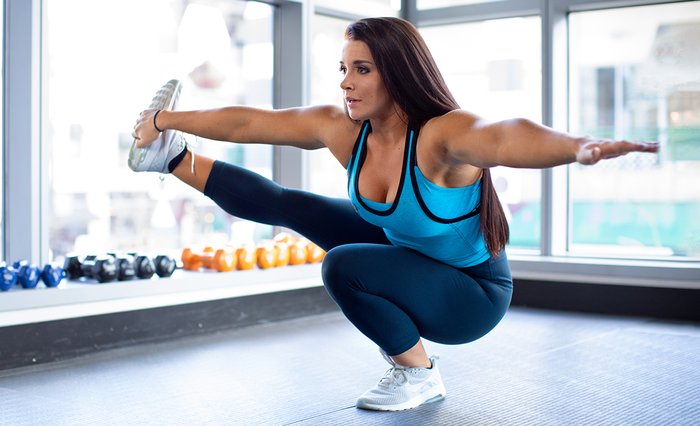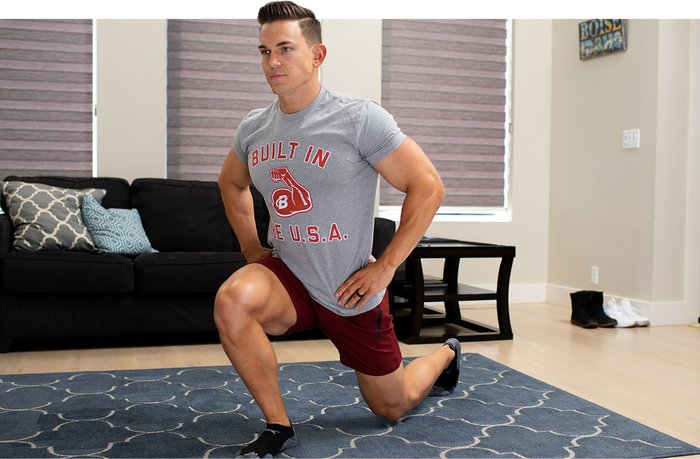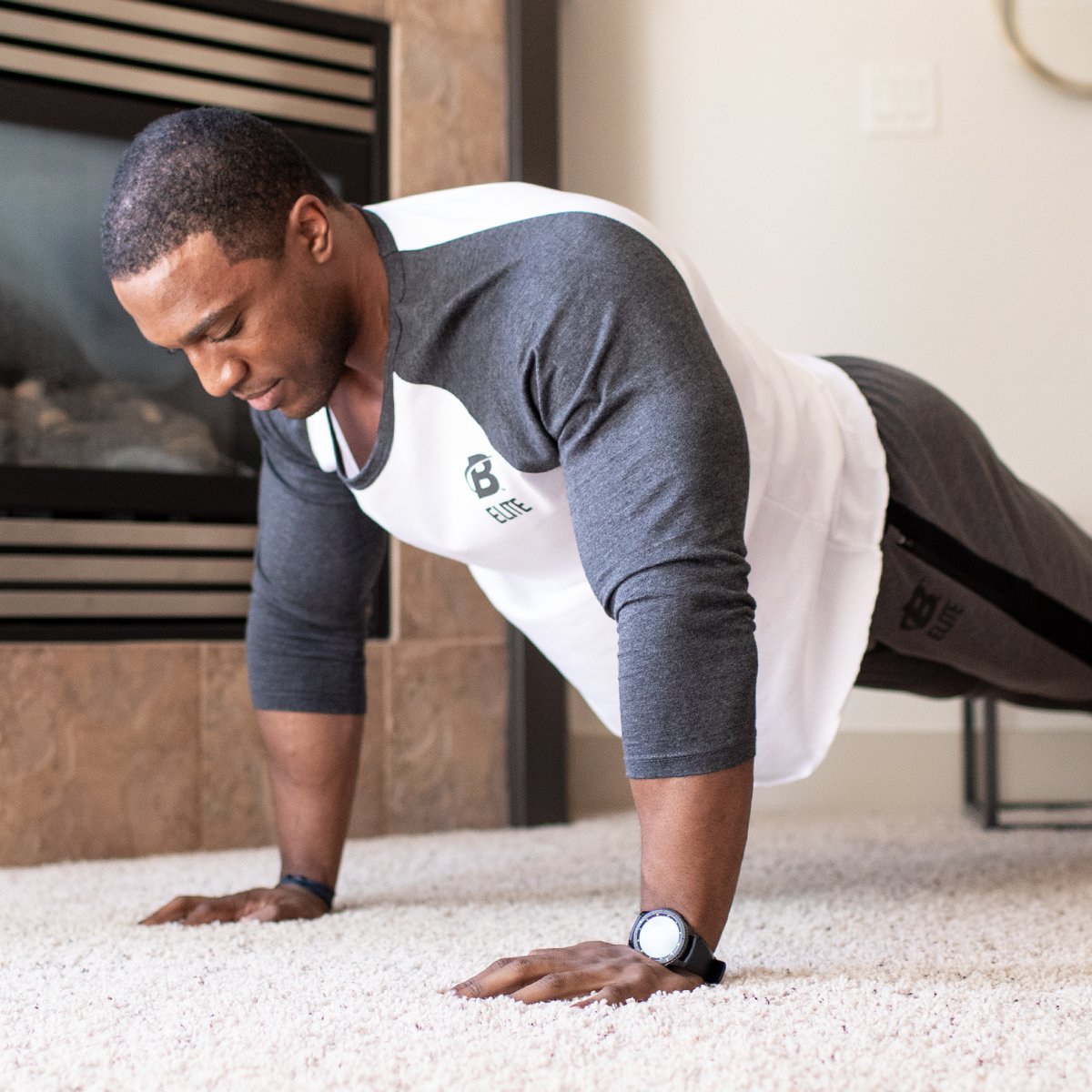In March, I made the difficult but necessary decision to close the doors at JKConditioning, a personal training gym in St. John's, Newfoundland, Canada, that I co-own with my wife. Ever since, it's been sad and surreal that I can't go into work and do what I love. The spread of COVID-19 has closed gym doors across the world, leaving many people, including my clients, stuck at home with minimal to no exercise equipment. Some are opening up again, but definitely not all. And a few, sadly, will probably never open again.
For those of us who feel that not training simply isn't an option, that means we have to adapt to a new environment with minimal weights or fancy equipment—or maybe no equipment at all. But that doesn't mean we have to stop working out and it definitely doesn't mean our progress has to stall. We just have to think outside the box and be creative.
Extraordinary circumstances require extraordinary measures, and hopefully extraordinary gains! It might also be a blessing in disguise to give your body a break from the heavy barbells and free weights.
No matter if your gym is opening up again, you're still on lockdown, or you're just planning ahead, this is a time to take stock of what we can do with what we've got—especially if we only have our bodies. Here are three ways to upgrade your at-home bodyweight workouts. They can apply to many different movements, but we'll focus on one: the push-up.

Think like a Gymnast
If you're training for strength and doing programs similar to 5x5 or 5/3/1 for the main lifts, you obviously can't do them without equipment at home. Instead of giving up and throwing in the towel, when training at home, take inspiration from the strongest bodyweight athletes out there: gymnasts.
Many of them never touch a weight in their life while they focus on perfecting bodyweight movements, and they're both jacked and incredibly athletic. How does this happen? Because they master one version of an exercise, and then progress to a harder, more tension-driven version of that exercise. A "harder" version of an exercise for them is one where they use leverage, tempo, and range of motion to put their body at a greater disadvantage, turning what would be a high-rep burnout into a low-rep strength move. Here's how you can do the same.
Upgrade 1: Manipulate Leverage
Pseudo Push-Up: If you think push-ups are easy, that's because once you hit a certain level of strength, they are. Think about it this way: If you pick up a barbell at one end with the other end on the ground, it doesn't weight 45 pounds, it weighs a portion of 45 pounds because the other end of the barbell is resting on the ground. This is essentially how a regular push-up works—and, like the landmine barbell press, it's a great movement. But you can—and occasionally should—make it more difficult. The simplest way to do that? Move closer to the center of the weight.
The pseudo push-up may be the upper-body challenge you're looking for. It's sometimes taught as a progression toward a planche push-up, a very difficult move that results from making one small change to the push-up: moving your hands closer to your hips. Even moving an inch or two from where you're accustomed to forces your hands to carry more of your body weight with each rep—and that's why these push-ups feel so much harder.
At first, start with your hands near the bottom of your ribs with your thumbs pointing forward. This will be difficult enough if you've never tried this style of push-up before. Put as much of your body weight in front of your hands as possible, and engage your abs by pushing your ribs up and protracting your shoulder blades. This is referred to as the "hollow body" position in gymnastics. Mastering this position is essential to performing the pseudo push-up correctly, but it will also have great carryover to all your other core-intensive strength work. Aim for 5 sets of 5 perfect reps.
Pistol Squat: To upgrade a bodyweight squat, stand on one leg. Simple enough, right? Sure, right up to the point where you try to do one. Pistol squats are a classic single-leg squat variation where the lifter squats truly "ass to grass" with the opposite leg held out straight in front of the body. You don't see this exercise commonly performed at local gyms because, well, it's quite difficult.
That means you could skip it, but I prefer to look for ways to do it instead. Ankle flexibility is a limiting factor in being able to squat all the way down, so it might help to elevate your heel by 1-2 inches. If you find these difficult, place your hand on top of a table or hold on to a doorknob to help with the up phase and balance. If you find these too easy, try performing them while standing with one leg on the arm of your couch. With this setup, you can let your opposite leg drop on the outside of the couch. Try to build up to 4 sets of 12 reps per leg.

Airborne Lunge: If you find that pistol squats put too much pressure across your knee joint, your single-leg squat should be the airborne lunge instead. This is another true single-leg squat variation where the opposite leg is held behind the body during the squat. Aim to touch your rear-leg knee gently on the ground. This signifies the bottom of the rep.
You'll have to lean over quite a bit, especially at first, to find the balance point, and it might further help to hold your arms out in front of your body. Don't touch your toes to the ground or push off your rear leg. The challenge here is to still build up to 4 sets of 12 reps per leg.
Single-Arm Assisted Chin-Up: If you have a chin-up bar that sits in your door frame, you're in luck! To upgrade your chin-up, instead of doing a regular "bilateral" chin-up, shift your weight more to one arm and try single-arm assisted chin-ups. Here, your opposite hand can assist your focused arm. Try to split the weight 80/20: 80 percent of your weight held in your focused arm and 20 percent in the assisting arm. Build up to 4-6 sets of 3-5 perfect reps.
Upgrade 2: Manipulate Exercise Tempo with Isometric/Dynamic Reps
Increasing the weight moved obviously makes any exercise harder, but when you're stuck without weight, you'll have to adjust a different metric, in this case, the set and rep scheme.
To upgrade the push-up—or any other bodyweight staple—try doing a 10-1 isometric/dynamic rep scheme. Here's how:
Hover in the bottom position for 10 seconds. Make sure all the tension is in the target muscles to hold you in that position. You're not resting down there! Now, after 10 seconds, perform 10 regular dynamic reps. Don't lock your joints at the top; keep tension in your chest and triceps. Next, hold the bottom position for 9 seconds, and then do 9 regular reps.
Continue this countdown until 1, if you can. You probably can't, at least at first. That equals 1 set. Do up to 4 sets, resting for a minute or so between them. Want to cry? Try it with squats, split squats, or meanest of all, rear-foot-elevated split squats. This is like the opposite of the 1-10 ladder protocol I recommended in the article, "3 Ways to Spice Up the Rear-Foot-Elevated Split Squat."
Upgrade 3: Manipulate Range of Motion with 1.5 Reps
Hope you liked it down in the bottom position of that push-up! You're about to spend even more time down there.
A great option to upgrade bodyweight exercises involves adding partial reps among the full reps, commonly referred to as "one and a half" reps. You may know these already, but chances are you've been skipping them—because they're not exactly everyone's idea of "fun."
Here's how it works: Go down to the bottom position of a push-up (or squat, or lunge). Only come up halfway before going down to the bottom again. Then, come up about 80 percent of the way. Again, don't lock your joints at the top of the exercise so you can keep constant tension on your target muscles. This will maximize your time under tension in the target muscles, a necessary component to building muscle.

To up the difficultly even more, you can also wear or hold onto a heavy backpack during the 1.5-rep sets. No target sets and rep here! Just go for broke.
Itching to try 1.5 reps and other upgraded bodyweight exercises? Try Full-Body Muscle-Building Home Workouts, exclusively in BodyFit!

